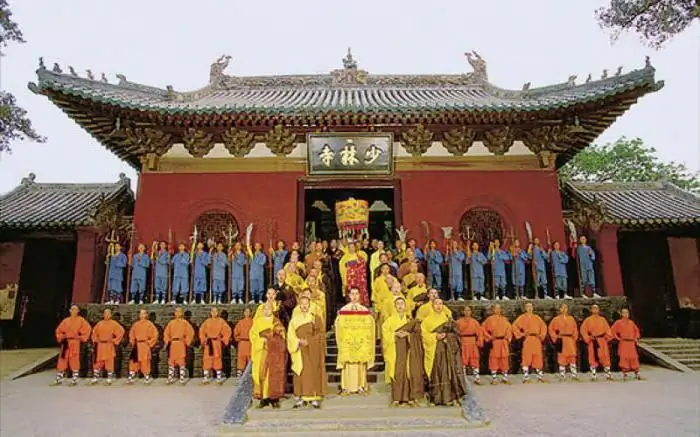- Author Harold Hamphrey [email protected].
- Public 2023-12-17 10:06.
- Last modified 2025-01-24 11:10.
Sometimes the main street of the Russian capital is called the Arbat, that part of it that is adapted for walking and mastered by tourists from all over the world. Those who came to see Moscow sights, to make excursions along the generally accepted Moscow routes, think so more often.

For those who managed to feel the spirit of the capital, there is only one main street in Moscow - Tverskaya.
Along the Piterskaya
Today it is one and a half kilometers of the city highway of intense car traffic, almost around the clock. Formally, Tverskaya Street is a section of the road between two squares - Manezhnaya and Triumfalnaya. Then the 1st Tverskaya-Yamskaya street begins, which at Tverskaya Zastava becomes Leningradsky Prospekt. In a broader sense, the main street of Moscow is what was called Moscow Broadway: Soviet-era Gorky Street, the route from the Historical Museum to the Belorussky railway station.

This street has come a long way - from the first wooden buildings of early Moscow to the veryprestigious area of the metropolitan metropolis. It has been influenced by all major architectural styles, and was the first to introduce technical innovations in the field of transport and urban improvement.
Starting from the 12th century
Tver Principality was one of the strongest of those located near Moscow. Therefore, the road to it existed from very early times. And from the very beginning, this direction took on the character of a ceremonial and representative one. The main street of Moscow, whose name gave a geographical direction to an important neighboring city, quickly began to improve. It was one of the first to be paved with a strong white stone, the poor houses of workers and service people were replaced by merchant and boyar mansions.
Monasteries and temples occupied an important place in shaping the appearance of this district of the capital. A dozen churches and three monasteries were located on a small area: Moiseevsky at the beginning, Voskresensky in the middle and Strastnaya in the area of present-day Pushkin Square.
With the founding of the Northern capital, the main street of the city of Moscow acquired the significance of the main entrance for sovereigns and the court, who came from St. Petersburg to Moscow. Unofficial names have been assigned to the street - Tsarskaya and Piterskaya.
After the fire
After the Napoleonic invasion, Tverskaya was rebuilt. The desire to give a European look to the main city thoroughfare could not overcome the traditional Moscow variegation. Solid representative buildings, luxurious hotels and shops alternated with small shops and country houses.

The main street of Moscow before the global Stalinist restructuring had a width of no more than 20 m. This did not correspond to its purpose as the central metropolitan highway.
Technical innovations
Large-scale electric street lighting in Moscow began from Tverskaya. By the coronation of Nicholas II in May 1896, 99 electric arc lamps were installed on it. The first experiments on the laying of asph alt concrete for the construction of sidewalks and pavements were also carried out on Tverskaya in 1876.
The main street of Moscow, Tverskaya, is the most important element of the transport network of the capital. It has always been the route of ground public transport of various types. In 1872, the first horse-drawn railway line was laid from Tverskaya Zastava to the center. Konka became one of the first successful types of urban public transport - in total, about 100 km of horse-drawn railway were laid across Moscow. The history of Moscow trams and trolleybuses also began on Tverskaya.
Great redistribution
In the mid-30s of the XX century, the largest reconstruction of the central part of Moscow began. The changes affected Tverskaya, and they began with the renaming. The main street of Moscow, whose name now sounded like Gorky Street, united Tverskaya and 1st Tverskaya-Yamskaya.
The town planning plan of 1935 provided for a global expansion of the carriageway and sidewalks from 18-20 to 60 m. This was supposed to be done by extraordinary means. Many buildings were demolished, among which were real masterpiecesarchitecture, and some buildings weighing hundreds of thousands of tons were moved tens of meters.
Buildings, erected in a short time along the newly marked red line, had a stylistic unity, which was dictated by the will of one person. Together with those buildings that were preserved during the reconstruction, they formed an impressive and expressive ensemble, a showcase of the main socialist city.
Main Attractions
The appearance of Tverskaya Street is largely determined by the squares - Pushkinskaya, Tverskaya and Triumphalnaya, their architecture and monuments located on them. In addition, there are several objects of historical and artistic heritage:
- House No. 1/15 - National Hotel (1903). Prominent figures of culture and science, political and public figures of the country and the world have stayed here.
- No. 5/6 - Postnikovsky Passage (Dolgorukov Palace). After numerous reconstructions, it became a theater building, now there is a theater named after. Yermolova.
- No. 7 - Central telegraph office with the famous globe. Monument to Constructivism (1927), built by architect I. I. Rerberg.

- No. 13 - The building of the Moscow City Hall (House of Moscow Governors-General), an architectural monument, the fruit of creativity of different generations of architects, among which are M. F. Kazakov, I. A. Fomin, D. N. Chechulin, M. V. Posokhin and others
- No. 21 - English club (Razumovsky Palace). Associated with the names of the classics of literature and art.
- No. 14 - Eliseevsky store, built by M. F. Kazakov.
- No. 10 - Filippov's bakery.
- No. 18-b - The building of the publishing house "Russian Word" (1906).






